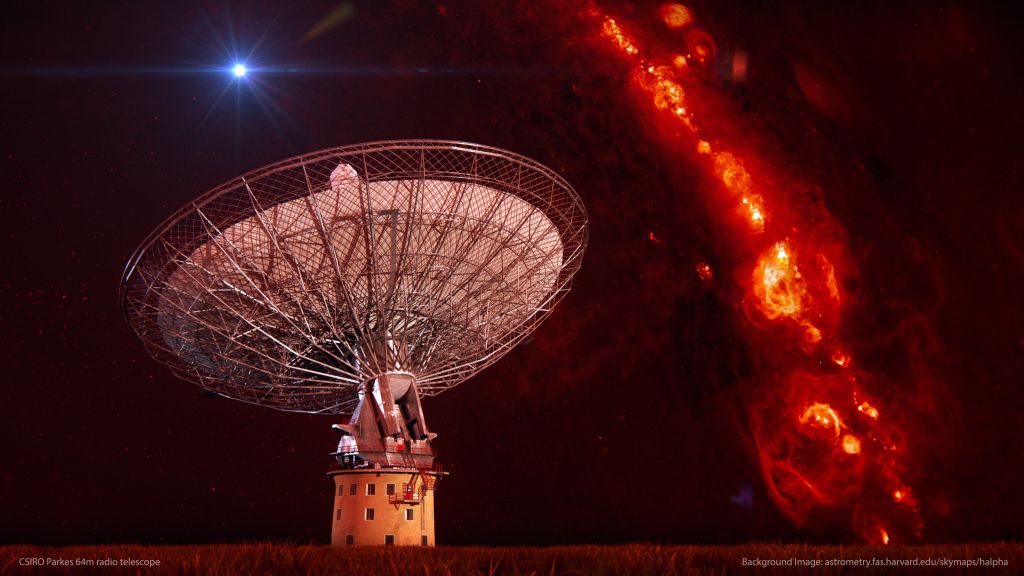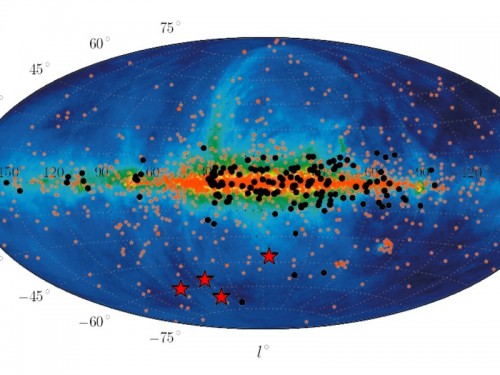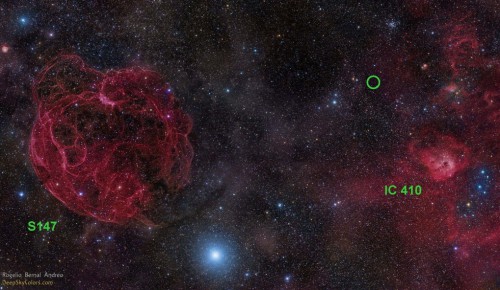
In 2007, David Narkevic, then a physics and political science undergraduate student at the West Virginia University, discovered a very powerful, ultra short radio burst that had seemingly come from beyond the Milky Way, while he was re-analysing archival data from 2001 that had been collected with the iconic 64-m Parkes radio telescope in Australia. The nature of this powerful, 4.6-millisecond-long signal, which was hidden inside a “haystack” of 480 hours’ worth of data, proved to be quite elusive while bearing no resemblance whatsoever to other known, previously discovered cosmic radio bursts. The enigmatic signal, named “the Lorimer burst” after Dr. Duncan Lorimer, an astronomy professor at the West Virginia University and Narkevic’s supervisor, thus remained a strange peculiarity for years, without reappearing in follow-up scans of the same part of the sky. A new cosmic mystery had been born.
The history of astronomy is replete with instances of unexpected findings that defy explanation at first, ultimately leading to a better understanding of the Universe in the process. Such was the case with the startling discovery in 1967 of a mystifying radio source in the direction of the constellation Vulpecula, which emitted short radio pulses with a period of 1.33 seconds and that would be later identified as coming from a previously unknown type of collapsed stars, called pulsars. During the same time, the then-recently deployed network of U.S. Vela satellites, which constantly monitored for any gamma ray pulses that would be emitted from a possible testing of nuclear weapons in space by the former Soviet Union, detected a series of unexpected short flashes of gamma rays that proved to be of a cosmic origin instead. Decades would pass before astronomers could understand the origins of these short-duration cosmic gamma ray bursts, which last from a few milliseconds up to a few minutes, finally associating then with some of the most energetic astrophysical phenomena in the Universe, like the collapse of supermassive stars and the formation of black holes in far away galaxies.

The mysterious Lorimer burst, which represented the first discovery of what came to be known as a “Fast Radio Burst,” or “FRB,” similarly stirred much speculation among the scientific community when it was detected in 2007. At the time, the short-lived radio signal, named “FRB 010724,” was initially considered by many to be either the result of an instrument glitch at the Parkes radio telescope, or of a man-made radio interference. Even though it seemed to be coming from the direction of the Small Magellanic Cloud, a satellite galaxy to the Milky Way located approximately 210,000 light-years away, the burst’s transient nature, coupled with the lack of detection of similar radio signals in follow-up observations, made many astronomers to doubt about their astrophysical origin. Nevertheless, FRB 010724 exhibited a wavelength dispersion which indicated that it had most likely come from beyond the Milky Way galaxy. When radio waves are emitted by a cosmic radio source along our line of sight, they are dispersed by the ionised gas of the interstellar and intergalactic medium, which causes their lower frequencies to arrive on Earth later than their higher ones. This time delay in the arrival of the radio wavelengths is dependent on the electron density of the intervening ionised gas. The longer the delay, the greater the density of the intervening medium and the longer the distance that the radio waves have to travel to reach Earth. By measuring the dispersion of FRB 010724, Lorimer’s team calculated that the latter must have travelled a distance between 1.5 and 3 billion light-years before arriving on Earth. This meant that with a recorded peak density flux of 30 Jy, FRB 010724 should have the same energy output as that of several billions of Suns during a single second, ranking it among the most energetic radio sources ever to be discovered. Yet, despite these tantalising evidence, the discovery of FRB 010724 still represented a single detection. Additional observations of similar events were needed for astronomers to be able to understand if they were indeed witnessing a new, previously unknown astrophysical phenomenon.
These came in 2013, when an international team of astronomers, led by Dan Thornton, a postgraduate student at the University of Manchester, U.K, discovered four more fast radio bursts also with the Parkes radio telescope, while looking for pulsars and other short-time-scale radio transient sources as part of the High Time Resolution Universe survey. The four new fast radio bursts, named FRB 110220, FRB 110627, FRB 110703, and FRB 120127 respectively, were discovered in the southern skies more than 40 degrees from the galactic plane, while lasting only a few milliseconds. By measuring their dispersion, Thornton’s team calculated that it was almost three times bigger than that of the Lorimer burst, indicating that they must lie between 5 and 10 billion light-years away. “A single burst of radio emission of unknown origin was detected outside our Galaxy about six years ago but no one was certain what it was or even if it was real, so we have spent the last four years searching for more of these explosive, short-duration radio bursts,” said Thornton, following the announcement of the FRBs’ discovery. “[Our study] describes four more bursts, removing any doubt that they are real. The radio bursts last for just a few milliseconds and the furthest one that we detected was several billion light years away.” Furhtermore, extrapolating from the number of FRB detections and the total time devoted to their search, as well as the total area of the sky scanned to date, Thornton’s team made an event rate analysis of FRBs concluding that these mysterious transient phenomena must occur every 10 seconds anywhere in the sky. “The bursts last only a tenth of the blink of an eye,” says Dr. Michael Kramer, Director of the Max Planck Institute. “With current telescopes we need to be lucky to look at the right spot at the right time. But if we could view the sky systematically with ‘radio eyes’ there would be flashes going off all over the sky every day.”

Despite giving a much-needed confirmation to the existence of fast radio bursts, the discoveries by Lorimer and Thornton nevertheless had one caveat: They were made with the same instrument, the Parkes radio telescope. Some scientists were still skeptical because of this very fact, regarding the nature of these elusive radio bursts from the sky. Would other observatories around the world be able to discover any similar radio signals at cosmological distances, or had the already detected FRBs originated from more terrestrial sources? The answer to this question came earlier this year, when a team led by Dr. Laura Spitler, a post-doctoral researcher at the Max Planck Institute for Radio Astronomy in Bonn, Germany, published the results of their study at the July 10 issue of the The Astrophysical Journal, detailing the discovery of yet another fast radio burst event, this time with the Arecibo 305-m radio telescope in Puerto Rico. The radio telescope recorded the new burst, named FRB 121102, on 2 November 2012, which was later found by Spitler’s team during an analysis of archival Arecibo data that had been gathered between March 2009 and December 2012, as part of the Pulsar Arecibo L-Band Feed Array survey, or PALFA, which scanned the plane of the Milky Way for new pulsars. “Once I saw the characteristic signature of an astrophysical burst, I immediately looked at the data in various ways to convince myself – and everyone else – that it was real,” says Spitler. “The process is not glamorous.”
FRB 121102 was detected in the direction of the constellation Auriga in the northern hemisphere, while lasting no more than 3 milliseconds. Despite being observed very close to the galactic plane, its dispersion measure was found to be three times higher than that of other sources that lie inside the Milky Way, indicating that it had likely originated from beyond our galaxy. “Our result is important because it eliminates any doubt that these radio bursts are truly of cosmic origin,” says Dr. Victoria Kaspi, an astrophysics professor at the McGill University in Montreal, Canada, and co-author of the study. “The radio waves show every sign of having come from far outside our galaxy – a really exciting prospect.” Besides independently confirming the cosmic origin of fast radio bursts, the recent study by Spitler’s team echoed the results of Thornton’s team, regarding the FRB’s overall occurrence rate. “There are only seven bursts every minute somewhere in the sky on average, so you have to be pretty lucky to have your telescope pointed in the right place at the right time,” says Spitler. “The characteristics of the burst seen by the Arecibo telescope, as well as how often we expect to catch one, are consistent with the characteristics of the previously observed bursts from Parkes.”

A host of theories has been proposed through the years attempting to explain the causes behind these fleeting cosmic radio flashes, including superconducting cosmic strings, evaporating black holes, and the merger of rapidly rotating pulsars in distant galaxies, as well as the sudden flare up of extremely magnetized neutron stars, called magnetars, just to name a few. Yet not all scientists agree that FRBs are of an extragalactic origin. In a study published earlier this year in the Jan. 2 issue of the Monthly Notices of the Royal Astronomical Society, a team led by Dr. Abraham Loeb, a Frank B. Baird, Jr. Professor of Science at Harvard University, argued that FRBs were in reality much closer to home, caused by stellar eruptions from stars that lie inside the Milky Way. The high electron density inside the coronae of these stars would mimic, according to the researchers, the radio dispersion effects of the intergalactic medium making FRBs appear more distant than what they really are. “We propose that fast radio bursts aren’t as exotic as astronomers first thought,” says Loeb. Despite all this theoretical speculation however, the real causes behind FRBs still remain unknown. “We really have no handle on what they are,” admits Spitler.
In the meantime, researchers are planning to conduct many more rigorous studies of these mysterious radio signals, whose elusive nature have intrigued the scientific community for years, in the hopes of finally uncovering their secrets. “Now, with the discovery of a burst from Arecibo, we are more confident that FRBs are astrophysical phenomena, and discovering and classifying them should be a priority of radio astronomical observatories in the future,” adds Spitler. “The Effelsberg radio telescope [located in North Rhine-Westphalia, Germany] has great potential for detecting many of these bursts. We are sure that there are bursts to be found in archival data from radio pulsar surveys at Effelsberg, and currently we are working hard to implement a system that will detect bursts in real-time. Real-time detection is an important step forward as it enables follow-up observations with facilities at other observing bands, which is crucial to understanding this mystery.”
As with every other mystery in the history of astronomical research, the solution to the fast radio burst enigma promises to be a fascinating one, providing us with new and important insights into the hidden processes of our Universe.
Want to keep up-to-date with all things space? Be sure to “Like” AmericaSpace on Facebook and follow us on Twitter: @AmericaSpace




Fascinating post! I haven’t heard anything about this before, I’m interested in looking further into the matters.
Brandon Doyle
Fascinating indeed! Like you, Brandon, something of which I was also unaware and would like more information on the subject.
Leonidas, you’ve done it again, offering new insight into another cosmic mystery! More to follow, I hope! Thank you.
Thank you Tom and Brandon!
I tried to keep the article relatively short, while presenting the key aspects of this fascinating cosmic mystery at the same time. I’m glad that it has served to wet your appetites on the subject. Indeed, the whole fast radio burst phenomenon deserves much study and analysis and of course I will be keeping an eye and report any new information on the subject, in the future.
There has also been a very good article regarding FRBs by the Scientific American magazine, which you can read here.
In addition to the recent study by Dr. Laura Spitler’s team which is mentioned in the article, you can also read the previous studies as well by Lorimer et al and Thornton et al, which present the discoveries of the first five FRBs in great (albeit highly technical) detail.
With kind regards,
Leonidas